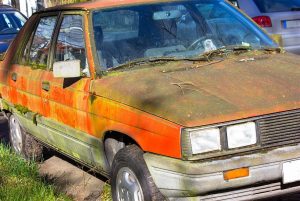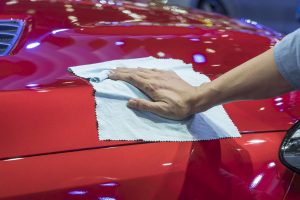How to Restore Your Car’s Paint to a Perfect Shine
There are a number of reasons why you should keep your car looking as sharp as possible—and it’s not always about pure vanity. One big reason is to preserve and restore its value. After all, you probably spent a lot of money to purchase your car, so it makes sense to make sure that your vehicle stays in good shape. A nice-looking car is undeniably easier to resell than some pile of junk that looks like it was stepped on by Godzilla. It also helps in creating a positive social impression—like when you go out on dates or travel to a job interview.
To a large degree, the process of maintaining a snazzy-looking car involves ensuring that the paint remains in decent condition, with a shiny, vibrant character. A lot of car owners, however, simply don’t give sufficient attention to their car’s paint, and, as a result, their car begins looking duller and duller as the months go by. Eventually, the paint can become so badly oxidized that it requires an extensive paint job to get it back to anything like its brand-new condition.
This doesn’t have to happen, though. Even if your paint job has begun fading, it’s usually not too late to put the shine back on your car. Below we’ll explore some tips for achieving this, but first let’s discuss a few things you need to know about your car’s paint.
Types of Paint
Back in the old days, car manufacturers applied what is called a single-stage paint job to their vehicles. These types of paints were thin, fragile, and excessively prone to oxidation (a phenomenon we’ll talk about a bit in the section below). Starting in the 1980s, car manufacturers began using a two-stage painting system; this involves applying first a base coat, then a clear coat on top of it. Two-stage paint is relatively durable and long-lasting, as well as more environmentally friendly. However, it can—and does—deteriorate if not properly cared for.
Assuming that you don’t drive a very old car, chances are that your vehicle has a two-stage paint job. That’s what we’ll focus on here.
Why Paint Goes Bad
When you take the keys from the salesman and drive your shiny new car off the lot, it’s natural to expect that your vehicle will stay in reasonably sound condition for years. What you may not realize, however, is that the rays of the sun are already wreaking havoc on that lustrous paint job.
What you may not realize, however, is that the rays of the sun are already wreaking havoc on that lustrous paint job.
The primary cause of paint deterioration is UV radiation from the sun—and it does more harm in a shorter span of time than you probably think. Whenever you leave your car parked under the blazing sun, your car’s paint undergoes an adverse chemical reaction. Exposure to dirt and other environmental pollutants also causes problems for your vehicle’s paint job.
Over time, the paint on your car will fade without proper care. Eventually, it reaches an advanced stage of damage known as oxidation—that’s when ugly white blotches appear, making your car look like it caught the plague.
If you’re really serious about preventing this type of damage to your car, then you should consider using a car cover, especially if you leave your car parked under the sun a lot. Some people even use car covers when they park their vehicles indoors; this practice keeps your car from collecting dust that could get into various internal components and cause premature wear.
It’s also a sound idea to get regular car washes to clear away contaminants that can harm your paint. However, what if your car’s paint has already begun fading? What if it’s too late to break out the car cover?
What to Do
So, now you’ve decide to do what you can to return your car to a reasonably shiny state. Here’s how you begin.
Wash the car – The first step is to give the exterior of your car a thorough cleaning. You need to get rid of all that debris that your car routinely collects when it’s out on the road. We’re talking not just about dirt, but also oil, fingerprints, bugs, and all those other random particles that somehow became attached to your car. Dawn dishwashing liquid is good for this purpose, but you can use whatever gets the job done. To make extra sure you’re as clean as possible, consider washing your car twice before doing any further work on it.
road. We’re talking not just about dirt, but also oil, fingerprints, bugs, and all those other random particles that somehow became attached to your car. Dawn dishwashing liquid is good for this purpose, but you can use whatever gets the job done. To make extra sure you’re as clean as possible, consider washing your car twice before doing any further work on it.
Remove surface contaminants – So, now you’ve completely washed your vehicle and gotten rid of all that dirt—or have you? What many people do not realize is that simple washing will not remove surface contaminants from their vehicle. What are these?
Surface contaminants comprise a wide range of particles from various sources: airborne pollutants, soot, tar, splattered bugs, paint overspray, and much more. Some of these
contaminants are not even visible to the eye—but they’re certainly present, and they interfere with your ability to get that pristine shine you want on your car. These contaminants become securely bonded to the surface of your car in a way that can be difficult to remove.
After you’ve washed the car, try this simple trick: Get a plastic sandwich bag and put your hand inside it, and then run your hand all over the surface of your car. The plastic bag enhances the sensitivity of your hand, allowing you to feel those tiny, tiny contaminants that you may not be able to detect otherwise. This will give you a clear sense of where contaminants are located along the exterior of your vehicle.
Now you will need to get some detailing clay; you can find a number of options at your local auto shop, like Sonus SFX Ultra-Fine Detailing Clay and Meguiars Professional Detailing Clay. This magical stuff can remove contaminants in a way that does not harm your paint, and it works best in conjunction with some clay lubricant (also available at your auto shop). Be sure to follow the directions provided.
Repair the paint – Now you should inspect your car for signs of paint damage, like scratches. If you have a minor scratch that affects only the clear coat, then you can fix it with some rubbing compound, available at any auto shop.
Make your car glossy – You will need to get rid of those tiny scratches and swirl marks, and you can do that by applying some car polish. Suitable car polishes available on  the market include Four Star Ultimate PreWax Cleaner and 3M One Step Cleaner Wax, among many others. Consider buying a rotary or dual-action polisher to help you with this, as it tends to produce better results than hand application.
the market include Four Star Ultimate PreWax Cleaner and 3M One Step Cleaner Wax, among many others. Consider buying a rotary or dual-action polisher to help you with this, as it tends to produce better results than hand application.
Apply sealant – By now, your paint should appear pretty crisp, but you need to ensure that it stays that way as long as possible. That’s what paint sealant can do for you; these are easy to apply and will protect your car for months. One brand is Klasse High Gloss Sealant Glaze, which will last up to a year after application. Another popular option is Wolfgang Deep Gloss Paint Sealant 3.0.
For really dedicated car enthusiasts, however, nothing beats carnauba wax for bringing out the beauty of your paint. If that’s an option you may be interested in pursuing, then you can come to one of Cobblestone Auto Spa’s locations and see for yourself why so many car collectors use carnauba wax on their prized vehicles.
Keeping your car clean may seem like more trouble than it’s worth, but it’s really not all that difficult—especially when you can turn to Cobblestone Auto Spa for expert car wash and detailing services.


